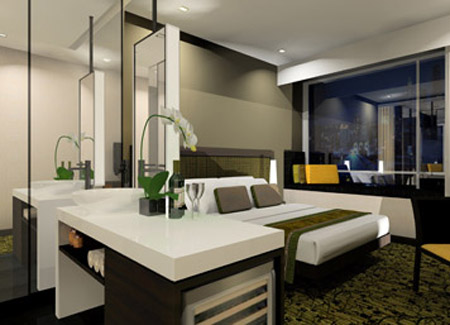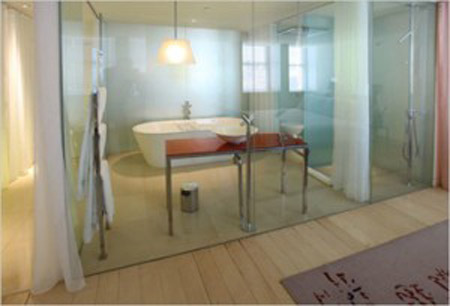Hotel Design Trends
Before the Global Financial Crisis started to truly take hold, architecture and interior design was often based on the ‘spectacular’.
Yet before then, and even now, there are some mainstream design trends that have started to genuinely redefine hotel architecture and interior design. Some of these trends have been caused by pressure on budgets, space, and sites, nonetheless the trends are obvious.

By this I mean there has been a fundamental shift in the traditional hotel room layout; the entry, bathroom, and bedroom. This is not just 3 star, 4 star, or 5 star phenomena, but a serious, ongoing - and I think long term trend.
For decades hotel rooms have generally included the standard bathroom box in the corner of the room. Boutique hotels have always tried to break away from this fixation as a point of difference, Philip Stark created his glass wall bathroom concept more than 10 years ago. However, the principle of breaking down the barriers within the room has been a challenge for designers for decades.

Boutique hotel designers have often tried placing a bath or spa bath within the bedroom with the usual problems of water, splash, housekeeping and maintenance.
I remember staying at a well known Boutique Hotel in London, some twelve months after it had opened and the bathroom timber was peeling due to water damage. Including a range of other defects, boutique hotels have often suffered from great initial ideas and aesthetics but impractical designs.
Having recently stayed in a couple of 4 and 5 star hotels, and experienced the challenge of designing a very tight-fit hotel in Singapore, I was invigorated and motivated to initiate a concept that had to be incredibly efficient in both space and budget.
For this project we were told the rooms would be 21sqm, yet as our design team progressed we became aware that we really only had 18sqm of space to work with.
How to design a 4 star hotel room, with all required facilities, in 18sqm?
The solution soon became very obvious, however not initially to the client. The blurred line between bathroom and room proper, a quintessential hotel design issue, had to be explored.
Taking references from some other great designs I had seen, we had to strip away the solid traditional separating wall.
What about privacy?
A window in the bathroom wall was not really going to be enough, even though we had done this many times before. This design required more than just visually linking the bathroom with the bedroom, and more than providing a connection to the view, the major requirement was to utilise space and efficiency. We needed to ‘multi-task’ the space rather than ‘dedicate’ space.
Modern technology and lower costs are enabling the use of glass walls or glass partitions with inter-layers to provide privacy. In addition, modern social customs and behaviours have enabled a blurring of privacy with intimacy.
Our design not only looked at a glass wall to make the room feel bigger, it stripped away the walls altogether, leading to a room that feels spacious, and can provide all the basic needs and functions required. The simple secret was to design the toilet and the shower on the corridor wall, and use frosted or colour-back glass to these cubicles for privacy. The bathroom vanity was then utilised and combined as the kitchen bench and mini-bar.
The vanity/bench becomes the central piece of furniture in the room and opens up an amazing depth of field.
With such a small room there was no real space for a separate mini-bar/refrigerator. Hence, utilising the bedroom side of the vanity for mini-bar, tea/coffee kettle etc, we were able to fit in all the functionality required in a 4 star room. The great space saving device of the vanity/bench, with privacy for the bathroom (including a pull down blind if required), and the translucent shower and toilet cubicle worked together to achieve this sensational design solution.
There is no doubt in my mind, having seen a few great examples of this paring back of the tradition bathroom wall - to create the generous spaciousness of the open plan hotel room, and having been through the same design experience myself, that a long term evolution in hotel design has occurred. This can only continue to develop and evolve over the coming years and provide us with a greater hotel experience no matter whether economy or luxury, large or small.
|

